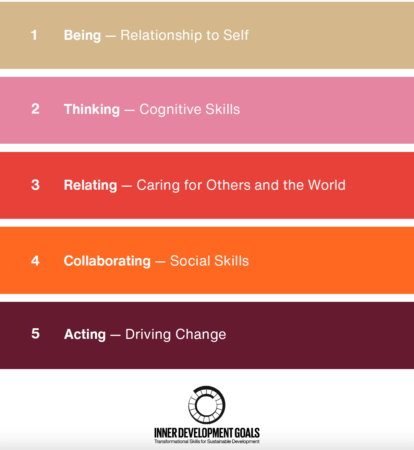The Inner and Sustainable Development Goals
What brings together a librarian, the executive director of an environmental organization, a leadership coach, a social entrepreneur, a retired health care leader and a group of other nonprofit professionals?
On November 10, 2022, SDG Cities hosted the fourth event of our Community Learning Series in an interactive workshop format to weave the Sustainable Development Goals and the Inner Development Goals. Jennifer Chesnut joined us to facilitate the workshop.
The common thread that brought the rich and diverse group of attendees together was the importance of building our inner capacity to address the challenges we face in our personal, professional and community lives, shifting how we show up and the impact of our work.
The end goal of the SDG Cities program is creating positive community impact and we understand that we need to cultivate our inner world to create the conditions for that to happen. According to Otto Scharmer, author of Theory U, the quality of our inner life will shape the quality of our relationships and ultimately our impact in the world.
Our workshop was primarily informed by two frameworks: the Inner Development Goals and the Work That Reconnects.
Inner Development Goals (IDGs)

Created to support the achievement of the SDGs, the IDGs are composed of 5 dimensions (being, thinking, relating, collaborating, acting) and 23 transformational skills that were identified based on the feedback of over a thousand participants and in collaboration with organizations across the world. Currently, Percolab Montreal is the Canadian IDG Hub.
“There is a vision of what needs to happen, but progress along this vision has so far been disappointing. We lack the inner capacity to deal with our increasingly complex environment and challenges. Fortunately, modern research shows that the inner abilities we now all need can be developed.” – Inner Development Goals
Work That Reconnects (WTR)

Developed over decades by Joanna Macy, WTR is designed primarily for groups and it can also be used by individuals. The main goal is to foster the desire and ability to participate in sustainability work. It adopts an experiential approach with four stages: gratitude, honoring our pain for the world, seeing with fresh eyes, and going forth.
“In the past, changing the self and changing the world were often regarded as separate endeavors and viewed in either-or terms,” noted Joanna Macy.
The Workshop
The workshop started with a check-in where participants were able to talk about the SDGs that are more relevant to them and to connect with each other, followed by an introduction to the two frameworks.
During the main part of the workshop, participants worked in pairs and Jennifer led the group through a practice called Callings and Resources, adapted from the book Coming Back to Life.
The exercise generated insights and many more questions through the process. Important to note that even though the practice has a structure and can be replicated, the results can not. Each group at a specific point in time has different needs and gifts. They will get their own unique insights every time. The workshop was not about finding answers. It was an experiment for cultivating habits for a healthy inner life and how to embed this in our current work, projects and organizations.
As such, the specific insights are relevant mostly for the participants and we won’t share their individual takeaways, we can share though some of the comments about the insights. We noticed that many of the comments reinforced the importance of art, beauty and spirituality in our daily lives and how these pursuits help people to remain whole and balanced. There were remarks about polarization and how we can use the same vocabulary but have different meanings. Also, we heard that it is important not to get trapped in our negative emotions and even to use them to move forward in an “artistry of rage”, channeling our energy for a good cause.
The Power of Our Inner World
Even though we have the knowledge and the resources to achieve the SDGs, developing our inner capacity is necessary to strengthen our individual and collective motivation. Building inner capacity is needed to improve our ability to work together, to deal with complex challenges and trauma, and to recreate the world to match our highest potential.
In a very tangible way, our minds shape our reality. Every single piece of the human built environment, and its artifacts, were originally in someone’s mind. This applies to not only the physical objects, but also all the social contracts including laws and agreements. Constructs like mortgage, marriage and even money are examples of what our inner world creates and brings to reality.
Our workshop just brushed the surface of our inner world. We look forward to more opportunities where we can cultivate ongoing practices for strengthening our 23 inner development skills to create positive change in the world and achieve the SDGs.
Guest facilitator bio

Jennifer Chesnut is an environmental educator and activist. She was London Public Library’s environmentalist in residence for spring 2022. She recently wrote a thesis on working with emotional responses to climate change. She is a facilitator in the Work That Reconnects, a peer-led process that supports groups in moving through eco-despair to empowerment.

